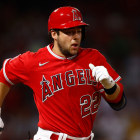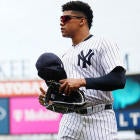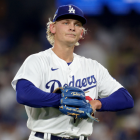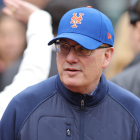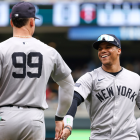The winter is still young but this has been a very active offseason for the New York Mets. They went outside the box and hired veteran agent Brodie Van Wagenen to run their baseball operations department, and also overhauled Mickey Callaway's coaching staff.
On the player side, the Mets have made what will probably go down as the biggest trade of the offseason, picking up Robinson Cano and Edwin Diaz in a seven-player trade with the Mariners. The trade details:
- Mets get: Cano, Diaz, and cash
- Mariners get: Jay Bruce, Anthony Swarzak, Gerson Bautista, and prospects Jarred Kelenic and Justin Dunn
I give Van Wagenen a lot of credit. This the most creative trade the Mets have made in a long time. They took on money down the road in Cano -- including Bruce and Swarzak in the trade lowers the short-term financial hit -- to get Diaz at a discount. Had the Mariners traded Diaz alone, he would've fetched more than Kelenic and Dunn, who are admittedly two really good prospects.
Even factoring in potential age-related decline with the just turned 36-year-old Cano, the trade gives the Mets massive upgrades on the infield and in the bullpen without subtracting anything they'll miss off their big-league roster. The Mets are a much better team today than they were before the trade. Just consider their 2019 postseason odds (via SportsLine):
- Before trade: 20.4 percent (10.8 percent to win NL East)
- After trade: 24.0 percent (12.7 percent to win NL East)
I know a 3.6 percentage point increase in postseason odds doesn't seem like much (and, honestly, it's not), but one trade can only move the needle so much. These Mets went 77-85 in 2018 and they weren't one Robinson Cano and one Edwin Diaz away from being NL East favorites. Van Wagenen and Co. still have work to do this offseason and they're expected to continue to be active.
After this trade, Mets plan to continue making aggressive moves this offseason. Roster will look very different Opening Day
— Andy Martino (@martinonyc) November 30, 2018
The Mets are starting with a solid talent base. Their rotation is quite strong even if Cy Young winner Jacob deGrom doesn't repeat his historic excellence -- their starters ranked sixth in ERA (3.54) and third in WAR (17.5) in 2018 -- and they have the makings of a good lineup with Cano on board. There's talent here. That said, the Mets still need help to be a no-doubt contender in 2019. The postseason odds are a reminder of that.
Where do the Mets go from here? Well, that's what we're here to discuss. Right now their projected 2019 payroll sits at $130 million or so when you include arbitration raises and whatnot. The Mets opened the last two seasons with a payroll right around $150 million. It appears Van Wagenen has some money to spend on his roster.
So, with that all said, let's break down what the Mets should do next now that Cano and Diaz are on board.
1. Get a catcher
Cano improves the infield and Bruce helps clear up the corner outfield logjam. The Mets could use a short-term upgrade over Juan Lagares in center field -- remember, once Yoenis Cespedes returns from his dual heel surgeries, that'll push Michael Conforto to center full-time -- otherwise catcher stands out as the club's most glaring positional need. Their catching depth chart:
- Travis d'Arnaud: Currently rehabbing from Tommy John surgery and may not be ready for Opening Day.
- Kevin Plawecki: Hit .240/.315/.370 in 2018 with below-average defensive numbers (per Baseball Prospectus).
- Tomas Nido: MLB.com's No. 10 Mets prospect. Went 10 for 84 (.167) in his brief MLB cameo in 2018.
d'Arnaud's had a very hard time staying healthy over the years and Plawecki has spun his wheels a bit in parts of four seasons with the Mets. Nido has some ability but probably isn't ready to take over as the clear cut No. 1 backstop in 2019. Not if the Mets want to contend, which they obviously do based on the Cano/Diaz trade.
Spending big on free agent Yasmani Grandal probably won't happen. Could they swing Wilson Ramos though? Or even Jonathan Lucroy? With all due respect to d'Arnaud and Plawecki, the Mets are starting from a pretty low baseline behind the plate -- their catchers ranked 25th in WAR in 2018 -- that they needn't break the bank for Grandal to improve. Ramos or even Lucroy would equal a few more wins in 2019.
2. Upgrade the bullpen
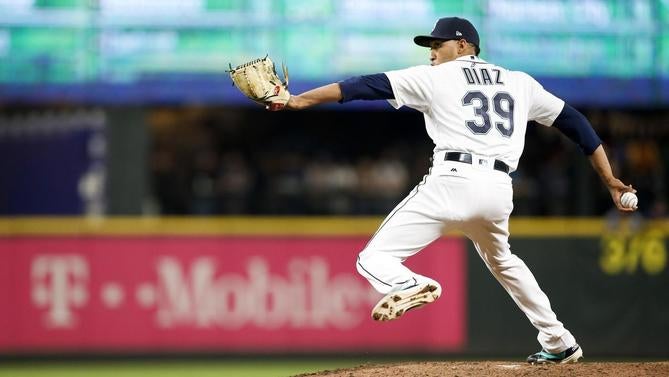
Diaz is, at worst, one of the top five relievers in baseball today, and it wouldn't be hard to argue he is the best reliever in baseball right now. The guy had a 1.96 ERA with 124 strikeouts and only 17 walks in 73 1/3 innings this past season. Opponents hit .160/.229/.241 against him. Diaz was overwhelmingly dominant and he makes the Mets a lot better.
That said, Diaz is only one man throwing one inning at a time. The rest of the bullpen is looking a tad bit shaky. This is the Mets' current bullpen depth chart:
- Closer: RHP Edwin Diaz
- Setup: RHP Robert Gsellman, RHP Seth Lugo
- Middle: RHP Tim Peterson, RHP Paul Sewald, RHP Drew Smith, LHP Daniel Zamora
- Depth: RHP Tyler Bashlor, RHP Drew Gagnon, RHP Jacob Rhame, RHP Bobby Wahl
Guys other than Diaz, Gsellman, and Lugo combined to allow 120 earned runs in 202 2/3 innings in 2018 (5.33 ERA). Guys other than Diaz, Gsellman, and Lugo project to allow 118 earned runs in 265 innings in 2019 (4.01 ERA) per Steamer, which is better than 2018, but still not great. Projections aren't predictions anyway. They're an estimate of talent level.
There is definitely room for help in the bullpen. The Mets may not swim in the deep end of the free-agent pool and pursue guys like Zach Britton, Craig Kimbrel, Andrew Miller, Adam Ottavino, or David Robertson. That's not their usual style. Lower cost relievers like Cody Allen, who manager Mickey Callaway worked with when he was the Indians pitching coach, Brad Brach, Jim Johnson, Tony Sipp, and Adam Warren could interest the Mets instead.
The expectation is the Mets will look to pair Edwin Diaz with a high-end eighth inning guy - David Robertson and Andrew Miller were two such names thrown at me - and also add a veteran multiple-innings type reliever to the bullpen.
— Mike Puma (@NYPost_Mets) November 30, 2018
Part of me wonders whether the Mets will commit to Diaz as their closer -- an obvious and easily justifiable move -- or be a tad more creative and use him as a high-leverage setup guy. Callaway was with the Indians when manager Terry Francona used Miller as has middle innings monster and brought him into the game's biggest situation regardless of inning. The Brewers used Josh Hader in a similar way this past season. The "Moment of Truth" reliever idea is spreading.
Using Diaz in that high-leverage setup guy role would require signing a closer or trusting either Lugo or Gsellman in the ninth inning. Miller and Hader worked in that role because the Indians (Allen) and Brewers (Corey Knebel, Jeremy Jeffress) had other guys capable of closing. Could Allen be a fit for the Mets? Or maybe a reunion with Jeurys Familia? Using Diaz in the game's biggest spot may equal more wins than marrying him to the ninth inning as a traditional. And, as an added bonus for the Mets, fewer saves means smaller arbitration raises for Diaz down the road. I think they acquired him to close though. Either way, bullpen help is required.
3. Commit to Alonso at first base
Former first round pick and top prospect Dominic Smith seems to have fallen out of favor with the Mets for a variety of possible reasons. He hasn't hit much in his limited MLB time (.210/.259/.406), but it's only 332 plate appearances spread across two seasons, so it would be sort of silly to give up on a 23-year-old with his pedigree.
Despite Smith's age and pedigree, Peter Alonso is the future at first base for the Mets. He's passed Smith on the depth chart, which is the kind of thing that happens when you put up a .285/.395/.579 batting line with 36 homers between Double-A and Triple-A, and continue launching bombs like this in the Arizona Fall League:
Think Peter Alonso is intimidated by 103 & 104 MPH fastballs? The #Mets' No. 2 prospect just turned around this 103 MPH heater at 110 MPH to put his team up 1-0 in the 1st inning of the @MLBazFallLeague Fall Stars Game. Watch live: https://t.co/xkzxDrU8TM pic.twitter.com/d3RV9EPb4G
— MLB Pipeline (@MLBPipeline) November 4, 2018
For what it's worth, Steamer projects Alonso as the Mets' third best hitter in 2019 -- the park-adjusted numbers put his offensive projection on par with Brandon Nimmo's -- and far better than Smith, Todd Frazier or anyone else the Mets could run out there at first base. The free-agent first-base market is weak -- Matt Adams and Mark Reynolds are the best of the bunch -- so, barring a surprise trade for Paul Goldschmidt, the club's best first base option next year is Alonso.
Of course, service time is a consideration here. The Mets did not call Alonso up late in 2018 because they didn't want to start his clock. Sixteen days in the minors next season would push Alonso's free agency back from the 2024-25 offseason to the 2025-26 offseason. Fine. Whatever. Send him down for 16 days in April, play Frazier at first base in the meantime (Jeff McNeil could man third), then bring Alonso up. He has legitimate 30-plus homer power and could be the team's full-time cleanup hitter behind Cano come the end of the season. Committing to Alonso is an easy potential upgrade.
4. Find some buy-low opportunities
When the Mets named Sandy Alderson their general manager back in October 2010, he came with a reputation for finding undervalued assets from his days with the Athletics. The ol' Moneyball strategy. Find players who are overlooked, plug them into your roster, and watch them thrive thanks to adjustments, proper usage (platoons, etc.), and an increase in playing time. The A's were the masters of it for the longest time. Now nearly every team does it.
That didn't happen with the Mets. Alderson didn't find enough low-cost/high-reward pickups to supplement the roster. Look at the Dodgers, who got Chris Taylor for a song. Or the Astros, who found Marwin Gonzalez in the Rule 5 Draft and plucked (former Met) Collin McHugh off waivers. Heck, look across town at the Yankees, who picked up Aaron Hicks, Didi Gregorius, and Chad Green when their value was down and developed them into well-above-average big leaguers.
The Mets haven't found enough (any?) of these buy-low opportunities in recent years and it is something Van Wagenen and his revamped analytics department -- the team recently hired analytics guru Adam Guttridge out of the private sector -- have to address. They don't run a high payroll relative to their market so getting production from the margins of the roster, whether it's a Taylor or a McHugh or a Hicks or a Brock Holt or a Joey Wendle, is essential. The Mets need one or two of their own.
5. Make a decision with Syndergaard
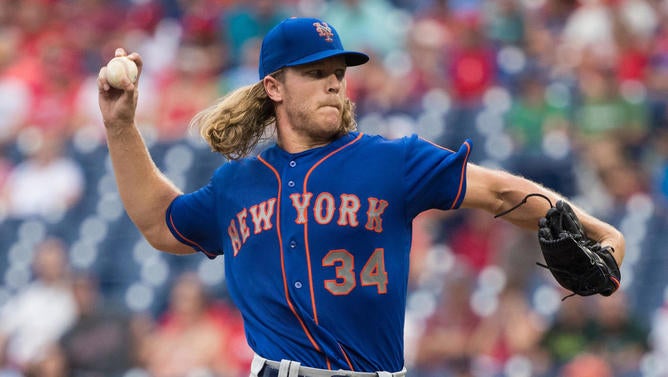
On the surface, it would be easy to attribute Noah Syndergaard popping up in trade rumors this offseason to general "every team listens to offers for every player" offseason talk. I just can't help but wonder whether Van Wagenen, Syndergaard's former agent, has some inside information that is pushing him to trade the stud right-hander.
It doesn't have to be anything nefarious, of course, like Syndergaard has been hiding an injury and his arm is about to blow out. But maybe Van Wagenen knows that, from his dealings as his agent, Syndergaard won't sign long-term with the Mets or is looking for a payday that simply doesn't fit in the team's payroll structure. The potential for this sort of "insider trading" hardly seems fair, but it is what it is.
The Cano/Diaz trade is the ultimate win now move and trading Syndergaard would run counter to that. He's been slowed by injuries the last two years but he has the potential to be a true world-beating ace. We've seen him do it. And yet, Syndergaard is on the market, even after the Cano/Diaz trade.
Sources: Mets are motivated to trade Noah Syndergaard with GM Brodie Van Wagenen initiating talks w/multiple clubs. Expectation is he will be traded this winter, FA SP will be signed to fill his spot. deGrom is off limits w/NYM hoping for extension. BVW used to be agent for both.
— Kiley McDaniel (@kileymcd) November 29, 2018
Trading Syndergaard after the Cano/Diaz deals seems counterintuitive -- and it is, really -- though I do wonder whether it's possible to trade him without suffering a big hit at the MLB level next season. One star is better than two good players -- for example, one 6 WAR player is better than two 3 WAR players because the 6 WAR player leaves you another roster spot to play with, and roster spots are a finite resource -- but perhaps there's a combination of players that would make trading Syndergaard make sense.
The Padres have been most connected to Syndergaard in recent weeks, right? Right. San Diego has the best farm system in baseball and they have a load of prospects to trade. Could the Mets land, say, top catching prospect Francisco Mejia and lefty Joey Lucchesi in a Syndergaard trade, plus more? Mejia is an elite MLB ready catching prospect who could step into New York's lineup right away -- quality young catchers are among the most valuable assets in the sport -- and Lucchesi could replace Syndergaard in the rotation. Not replace his production, mind you, but fill the spot capably.
Anyway, I'm rambling. When it comes to trade proposals from the media and fans and outsiders in general, a friend once told me "your trade proposal sucks," and no truer words have ever been spoken. That doesn't change the fact the Mets and Van Wagenen have to figure out what they want to do with Syndergaard. Trade him? Well, okay, but they must shop him around and get the best offer rather than try to fill specific needs. He is far too talented for that. Keep him? That's okay too. Preferable, even.
It is easy to freak out about a team coming off a 77-win season trading two top prospects like Kelenic and Dunn for a 36-year-old with a monster contract coming off a performance-enhancing drug suspension, but the Cano/Diaz deal is so much more than that. Cano is still quite good, for starters. The guy did hit .317/.363/.497 after coming back from the suspension -- a very Robinson Cano-looking batting line, that is -- and he still can still sting the ball.
Highest hard-hit rate, 2018
— David Adler (@_dadler) November 30, 2018
Min. 250 batted balls (228 hitters)
1. Aaron Judge: 54.1%
2. Kendrys Morales: 52.6%
3. J.D. Martinez: 52.4%
4. Matt Olson: 52.2%
*5. Robinson Cano: 51.7%*
...
55. Brandon Nimmo: 42.1% (#1 Met)
Cano's a big upgrade for the Mets, who can reduce Frazier's role and keep McNeil in the lineup at third base, and oh yeah they picked up maybe the best reliever in the game as well. Break the trade up into a Cano for Bruce/Swarzak salary dump and Diaz for Kelenic/Dunn/Bautista value swap and it looks quite good for the Mets. Like I said earlier, this is the most creative move we've seen out of them in quite some time.
There is still a ways to go -- a potentially long ways to go -- before the Mets are a slam dunk, no-doubt contender heading into the 2019 season. The American League is very top and bottom heavy with superpowers and rebuilders. The National League field is more level with a lot of okay teams but perhaps no truly dominant team. Because of that, the postseason races look to be wide open, and with a few more moves and some more creativity, the Cano/Diaz trade can be the start of Van Wagenen pushing the Mets back into October.

















